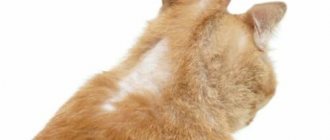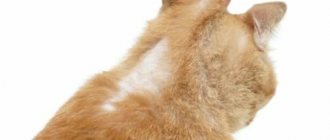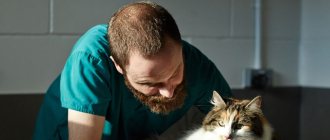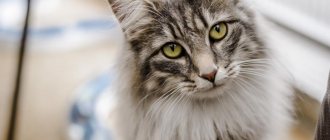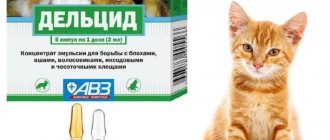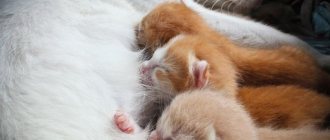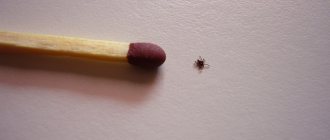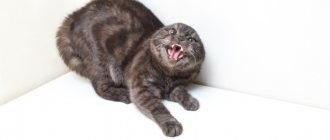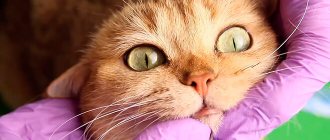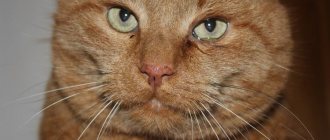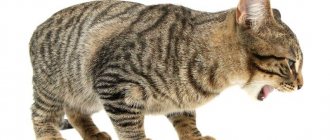Ringworm in cats is a fungal infection of an animal. What is the cause of the disease? In the first place is infection. Reduced immunity, allergies, and viruses are also prerequisites for the disease. More recently, 20 years ago, even 10 years ago, the disease was considered incurable. Pets were euthanized. Fortunately, today lichen in cats and kittens can be treated. The disease is contagious; it can infect other animals and, which is very unpleasant, people.
It is necessary to be vigilant and at the first signs of deprivation (we will talk about them a little later) not to self-medicate, but, having grabbed your pet, come to an appointment with a veterinarian for an accurate diagnosis. Many people encounter this for the first time, panic, search on forums, ask friends what to do? Yes, you can listen to advice, but! you should calm down and come with your cat to a doctor's consultation. By being patient and receiving the necessary treatment methods, you can help your pet recover.
In the article we will talk about the types of ringworm, its symptoms, and will dwell in more detail on the treatment of ringworm and prevention.
How is feline ringworm treated in humans?
If, through carelessness or ignorance, one of the owners became infected with lichen from a cat, then you should not panic, but consult a doctor. In order not to infect others, you must follow all the recommendations received :
- treating affected areas of the skin with a solution of iodine;
- adhere to the prescribed diet;
- taking antifungal and antihistamine medications;
- need to refrain from taking a bath;
- Under no circumstances should you rub the skin with a washcloth;
- carrying out immunotherapy.
It is quite possible to cure feline lichen in humans. For this purpose, the following iodine-containing solutions are used, namely: iodopirone, iodoform, dermicide, antistrumin and others. Treatment of the disease also includes taking one of the antifungal agents: terbinafine, griseofulvin, inraconazole. Of course, the affected areas of hair or skin must be lubricated with ointment: exoderil, lamisil, clotrimazole or ketonazole.
Treatment of a pregnant cat
How to cure lichen in a cat if she is carrying kittens? If a pregnant animal has been infected, under no circumstances take any measures without a doctor’s prescription. Traditional treatment can also harm unborn offspring; tablets, injections, ointments often contain aggressive toxic components. In this case, it is better to use anti-lichen ointment for animals; they do not penetrate into the bloodstream, and therefore are not harmful to kittens.
Traditional methods continue to remain prohibited; in the case of pregnant cats, they can lead to a deterioration in well-being due to the lack of the desired effect. It is strictly forbidden to use alcohol tinctures, iodine, brilliant green, so as not to injure the infected skin.
Ointments and shampoos for the treatment of lichen in cats
The most effective products produced in the form of ointments are:
- Clotrimazole - contains the active ingredient of the same name, which effectively helps eliminate ringworm in indoor and outdoor cats. The ointment must be applied to the area damaged by the fungus three times in 24 hours, and the course of treatment is about 30 days. Analogues of the drug - Mikosporin, Clotrisal. The ointment should not be used on pregnant or lactating animals. The drug can also be used in the form of tablets or spray.
- Sanoderm is an ointment containing betamethasone (anti-allergic, anti-inflammatory component), gentamicin sulfate (antibacterial component), nipagin (antiseptic), clotrimazole. The cream is distributed over the affected area twice a day, and after the animal’s condition improves - once a day. The course of treatment does not exceed 4 weeks. If re-treatment is necessary, you must wait 20 days.
- Miconazole is an antifungal agent with the active ingredient miconazole nitrate. To get rid of the fungus, it is enough to lubricate the lichen twice a day. The duration of treatment is from 1 to 2 months.
- YAM is a complex action ointment. The composition of the ointment provides effective control of parasites, while simultaneously providing an antiseptic effect on the infected area. Ringworm must be treated twice a day for 7 - 10 days. The animal's hair is not pre-cut. After completing the treatment course, new hair growth is observed at the site of the lesion. The drug is toxic, so it is not used to treat kittens.
- Griseofulvin is an effective antifungal agent that can be used to treat adult animals and kittens. The ointment is applied for 14 days, 2 times a day. To enhance the therapeutic effect, you can give Griseofulvin to cats in tablet form, adding them to food (0.25 tablets for adult cats and 0.12 tablets for kittens).
The range of effective antimycotics expands the anti-lichen shampoo for cats . The best known is Nizoral (the active ingredient is ketoconazole) and its cheaper analogue is Sebozol. The use of shampoos prevents the spread of lichen throughout the body and is suitable for the treatment and prevention of diseases.
Before treating ringworm in cats , you should consult with your veterinarian, as the instructions included with antifungal medications are often geared toward human awareness. Elimination of deprivation with the indicated doses of drugs can cause poisoning in pets.
Professional treatment
The pathology is difficult to treat, so owners must be prepared for a long course of treatment (1-1.5 months). This is due to the high viability of fungal spores and possible re-infection of the animal.
initial stage
For a small area of skin damage, special antifungal drugs for external use are prescribed as medications:
- Ointments;
- Sprays;
- Creams;
- Shampoos.
Of the ointments, Miconazole is the most effective.
Miconazole is an antifungal and anti-inflammatory drug that is used in veterinary medicine and human therapy to treat fungal diseases. The active ingredient of the drug is miconazole nitrate. The medicine has a bactericidal effect on a number of gram-positive and gram-negative bacteria. The ointment is inexpensive - from 85 to 100 rubles. in Russian pharmacies, 27 UAH. in Ukrainian pharmacies.
Owners of long-haired cat breeds are advised to trim the hair in the affected areas.
Severe form
In severe cases of pathology, complex treatment is necessary - in addition to external medications, oral medications are prescribed:
- intraconazole,
- terbinafine,
- griseofulvin.
The course and dosage of these medications is prescribed by a veterinarian. According to reviews on the Internet, Itraconazole is considered the most effective drug. You will find a description of these and other drugs below.
Do not forget that all objects that come into contact with a sick animal must be thoroughly disinfected.
Important!
All medical procedures must be carried out in disposable medical gloves - lichen is contagious to humans!
External preparations – ointments, solutions, sprays
Fungin
The drug, designed to fight fungal disease, is available in the form of a solution and spray.
The active ingredient of Fungin is clotrimazole, and the auxiliary ingredients are propolis and glycerin.
The drug is applied to the affected areas and lightly rubbed into them. Treatment is carried out regularly for two weeks, after which a control examination of skin scraping is recommended.
Manufacturers promise no side effects, but in reviews of animal owners there are references to excessive salivation, gastrointestinal disorders and skin reactions sometimes after using Fungin.
- A 30 ml bottle costs 85 hryvnia in Ukraine, and 310 rubles in Russia.
- The price of a spray (30 ml) in Ukraine is 115 hryvnia, in Russia – 415 rubles.
Yam ointment
They say that this ointment has no analogues. It’s difficult to judge, but the effectiveness of this drug is really very high.
According to the instructions, the ointment is applied in a thin layer to the affected areas of the skin at least twice a day for at least a week. After this period, the crusts disappear and hair begins to grow at the treatment site again.
Manufacturers do not hide the composition of Ointment Yam. These are salicylic acid, zinc oxide, sulfur, tar, turpentine, etc. The main thing is that the drug has astringent and antiseptic properties.
The price of a 20 gram package is 18 hryvnia in Ukraine and 75 rubles in Russia.
Sanoderm
The Ukrainian drug has both anti-inflammatory, anti-allergenic and antibacterial properties.
This versatility is ensured by the inclusion of betamethasone, which inhibits the accumulation of leukocytes, the antifungal clotrimazole and the broad-spectrum antibiotic gentamicin.
The course of treatment with Sanoderm is on average 2-4 weeks.
The product is available in 15 gram tubes.
Price: 55 hryvnia – in Ukraine, 110 rubles – in Russia.
Miconazole
Miconazole belongs to a group of drugs that works equally well in animals and humans. This ointment (made in Ukraine) is active against parasitic and pathogenic fungi, yeast, and bacteria (including gram-positive ones). The active ingredient is miconazole.
Treatment with Miconazole must be carried out for up to 6 weeks. Please note that even after the symptoms disappear, you need to treat the skin with this product for another two to three days.
A 15 gram tube is sold in Ukraine for 30 hryvnia, in Russia – for 163 rubles.
Imaverol
An effective drug for the treatment of fungal infections, available in the form of an emulsion for external use. The medicine does not penetrate deep into the tissue and acts on skin surfaces affected by lichen. It is quickly eliminated from the body naturally.
In veterinary medicine it is used as part of complex therapy as prescribed by the attending physician. The active ingredient of the drug, enilconazole, destroys fungal spores at the cellular level. Maximum effectiveness of the product is achieved when used simultaneously with other drugs.
Before use, the emulsion is diluted with water in a ratio of 1:5.
The course of treatment consists of 4 procedures, which are carried out at intervals of 4 days.
The price of a bottle (100 ml) is 1,450 rubles in Russia, 845 hryvnia in Ukraine.
Fukortsin
Disinfectant and antiseptic from Ukrainian pharmacists is available in 25 ml bottles.
The composition contains acetone, boric acid and resorcinol.
Veterinarians recommend treating animals with Fukortsin about 3 times a day until the symptoms of the disease (including crusts) completely disappear.
In Ukrainian pet pharmacies, Fukortsin (25 ml) is sold for 10 hryvnia, and in Russian - from 39 rubles.
Oral medications – tablets, capsules
Intraconazole
A synthetic antifungal drug is highly effective against ringworm. The active ingredients of the drug suppress the reproduction and development of the fungus. The drug is intended for oral use and is available in capsules. Approved for use in the therapy of cats and dogs, as well as people.
It is used as prescribed by a veterinarian in the complex treatment of ringworm.
The course of treatment is at least 1 month.
Price: pack (14 caps) in Ukraine – 43 hryvnia, in Russia – 320 rubles.
Terbinafine
Antifungal tablets prevent further spread of parasites and have a pronounced anti-inflammatory effect. The drug is administered orally as part of complex therapy for animals. The course of treatment and dosage must be selected by a veterinarian.
The course of treatment ranges from 32 to 34 days. The drug is best given to the cat during feeding once a day. At the end of the course, the dose is reduced - 1 tablet every two days.
Price: packaging (10 tablets) in Ukraine – 45 UAH, in Russia – 140 rubles.
Griseofulvin
An antifungal antibiotic with a cumulative effect. The active ingredient of the drug is Griseofulvin. The drug stops the cell division of the fungus. In veterinary medicine it is used to treat ringworm in cats and kittens. Not for use in animals with kidney and liver diseases, during pregnancy and lactation.
The medicine is given orally during feeding 2 times a day. Recommended dosage: 10 mg. per 1 kg. animal weight.
Course of treatment: 3-5 weeks.
Price: pack (20 tablets) – 195-220 rubles. in Russia, packaging (40 tablets) – 44-45 UAH. in Ukraine.
Treatment of deprivation
The treatment tactics for lichen are determined by the form and nature of the disease. In many cases, it is enough to put a protective collar on the cat against licking and promptly treat the affected areas of the skin with ointments; in severe cases, therapy should be comprehensive with the use of tablets, injections, and external agents.
It takes 2 weeks for skin wounds to heal, but complete recovery occurs in 4-6 weeks, provided that all the veterinarian’s recommendations are strictly followed.
Tablets, injections, and external remedies help to cope with ringworm. Before treating the sore spot, the hair around it is shaved off for better contact of the medicine with the skin. The list of drugs needed to treat ringworm:
- antifungal sprays (Dermazol, Nizoral);
- ointments (Yam, Lamisil, Miconazole);
- tablets (Terbinafine, Itraconazole, Griseofulvin).
Vaccines are used to treat and prevent disease in cats.
If a person is infected with shingles
A person who keeps furry pets in the house must be prepared for the fact that some diseases can spread from a sick cat to all family members.
Treatment of a person infected with lichen from a cat is carried out in parallel with the treatment of a pet. Complex therapy is used:
- all sore spots are treated with antifungal ointments, iodine, fucarcin;
- during treatment, do not take a bath or rub the skin with a washcloth;
- take antifungal and antihistamines orally;
- The diet includes a complex of vitamins.
Diagnostics
As with other diseases, only a veterinarian can make a diagnosis, confirm or refute your guesses.
The doctor will conduct a comprehensive examination:
- using a Wood's lamp, examine the affected area; the primary method will most likely indicate the presence of lichen - if the diagnosis is confirmed, the fur under the lamp will acquire a green tint;
- examination under a magnifying microscope makes it possible to examine skin scales in detail and see microsporia on the skin or hairs;
- analysis of the scraping for the presence of a nutrient medium - for analysis, a scraping is made from the affected area and sent to the laboratory to identify parasites and fungi.
The first two methods are carried out directly in the doctor’s office, take a few minutes, but do not give a 100% result. The culture is analyzed within 21 days, and its reliability is 100%.
Determination of ringworm with a Wood's lamp
Most types of lichen caused by fungus are determined using a Wood's lamp. The spores glow under the lamp with a bright green fluorescent color. The cat is brought into a dark room and ultraviolet light is directed at it.
Before the procedure, you should not treat the affected areas with ointments or powders, as this may complicate the diagnosis. The fact is that some medications also glow green when exposed to ultraviolet light.
You should also know that not all types of fungus can be determined using a Wood's lamp. For some species, you will have to take an analysis and do a culture. This method gives almost 100% results, but takes from several weeks to a month, since the spores grow for a very long time.
Ringworm
Now let’s take a closer look at what ringworm is in a cat. It is one of the most dangerous and common types of lichen. What is the danger and insidiousness of this disease? The fact is that the incubation period for lichen in cats can last from several days to several months. Other animals and unsuspecting people become infected. It is especially dangerous for long-haired breeds, since the hair prevents the first signs of the disease from being seen. How to treat ringworm in cats will be discussed a little later.
Let's consider what is the causative agent of ringworm? These are dermatophyte molds. There are two forms of ringworm:
- - microsporia;
- - trichyphytosis.
- What happens with microsporia?
- - hair fragility appears at the skin level;
- - wool hair is easily pulled out.
When hair falls out, other animals and people become infected with fungal spores.
Trichophytosis, the second form of the fungus, is very rare. With this type of ringworm, baldness appears only in the head and neck area.
There are three forms of the disease:
- -superficial;
- -deep;
- -atypical.
With a superficial and atypical form of ringworm in cats, for a long time it is impossible to notice that the disease process has already begun.
It is very important to identify the disease at an early stage; the method and time of treatment for your pet will depend on this.
Who is at risk and can get ringworm?
- -most often these are small kittens;
- - long-haired breeds (genetically predisposed to such diseases);
- - cats with malignant processes in the body;
- - cats infected with parasites;
- -young cats up to one year of age.
One of the most pressing and exciting questions is how is lichen transmitted from cats? Unfortunately, ringworm is contagious to humans. You love your pet, pet it, pick it up. Yes, usually upon contact the process of lichen infection occurs. This happens especially easily if there are scratches, wounds, or abrasions on your hands. You can become infected by dandruff, scales, and hair falling from a cat. Children can become infected very easily while playing in the sandbox. Your home, bowls, rugs, combs, etc. are contaminated. Fungal spores are very stable and viable. Will the person get sick or not? It depends on the type of lichen and the person’s immunity. Children and people with weakened immune systems are at risk.
Local preparations
Typically, these drugs are applied to the affected areas of the animal. Since they are not safe for internal use, it is necessary to put a wide collar around the cat’s neck to prevent the pet from licking the medicinal product from the body.
Shampoos
Antifungal shampoos are used to treat lichen in cats. Their action alone will not relieve a meowing pet from the disease; it should only be used in a comprehensive manner. It is also not recommended to mix anti-lichen shampoos with regular shampoos.
Nizoral and Sebozol are considered good ones. They contain Ketoconazole, which is excellent against various fungi, infections and bacteria. It is necessary to wash your pet with shampoo 2 times a week for 1.5-2 months.
Ointments, sprays, creams
There are many liquid preparations that help fight lichen in cats, the treatment of which has long been neglected. Before using any ointments, sprays or creams, the animal's skin must first be prepared by cutting short the hair around the lichen spot.
To cure ringworm in a cat, it is recommended to use ointments that contain Clotrimazole. It perfectly helps get rid of fungi, although its use will last at least a month. More advanced products with his participation are Sanoderm and Fungin. Their action heals wounds, relieves inflammation and itching.
The drug Miconazole has a good bactericidal effect. By rubbing it into your pet's skin, it destroys lichen fungi. Yam BC ointment also helps eliminate various dermatological diseases, including ringworm.
But Imaverol can be used to treat lichen in pregnant cats and kittens.
A good option for getting rid of lichen would be sulfur and salicylic ointments.
The affected areas of the skin are lubricated generously with ointment twice a day. The advantage of these drugs is their low cost.
General rules of treatment and safety
In addition to the treatment prescribed by the doctor, it is important to adhere to safety rules that will help cure the infection faster and prevent its further spread.
- For treatment to be effective, it is suggested that the animal be trimmed or shaved to facilitate access to the wounds.
- If the disease is contagious, sterilize your tools after cutting.
- Animal fur must be disposed of, preferably burned.
- Isolate your pet from other animals in the house and provide him with peace.
- Do wet cleaning, disinfect cat toys and change bedding daily.
- Carry out all manipulations with disposable gloves to prevent the fungus from getting on your own skin and mucous membranes.
- To prevent your cat from licking its wounds, purchase a special collar.
- If tablets are prescribed, ask your doctor if they can be crushed and read my article on how to give your cat a tablet.
Additionally, I recommend watching a video where the author shares useful tips on how to treat lichen and shows a homemade collar for a mustachioed friend:
Symptoms of the disease
Although each species is different, they have both common and individual signs of lichen in cats. General symptoms:
- hair loss in areas where the rash appears;
- inflammation, redness, dryness of the epidermis;
- constant severe itching.
Also, each species has separate, characteristic features.
Symptoms of ringworm
If your pet has contracted ringworm, there are several ways to identify it. Some parts of the fur will quickly fall out, but the rest of the coat will remain unharmed. Before this, the development of a small red rash on the body will begin. Because of them, the cat may itch for a long time. Often he finds no rest or suddenly wakes up from an attack of itching.
More developed lichen in cats can be determined by the following signs:
- the cat develops round spots covered with a crust of flaky skin;
- These areas are not covered with hair, and the hairs nearby thin out and become more brittle;
- if during the scratching process the cat scratches off part of the crust, a red smooth surface will be visible under it;
- over time, the spots increase in size and take on an oval or round shape;
- If the disease is not treated for a long time, hair will no longer grow at the sites of inflammation, as hard scabs will form.
The spots often cause discomfort and itch for animals. Depending on the pathogen, symptoms can affect the pet’s entire body or the head and neck separately. It also happens that some signs of lichen in cats are simply not expressed or are completely absent. This is called the apathetic form of the disease. In this case, only some hairs of the coat are susceptible to loss. Because of this, the disease becomes invisible to the naked eye, which means that the owner may not take any action to treat it for a long time.
Symptoms of pityriasis versicolor
Pityriasis versicolor in cats are pale, oval-shaped spots on the animal’s skin. They quickly spread throughout the body and after a few days occupy most of it. Then the spots begin to grow together, which can cause damage and deformation of the claws. In this case, the cat does not feel itching or any other severe discomfort. The spots may disappear if the surrounding temperature drops.
Symptoms of pityriasis rosea
Sometimes feline pityriasis rosea is confused with an allergy. The fact is that it appears as a small red rash on the skin. In some cases, the spots increase to 2 cm in diameter. A large accumulation of them is usually noticed on the pet’s stomach, in the groin and on the inside of the thigh. Itching is absent or almost not expressed.
The skin on which the spots appear becomes rough. If treatment has not begun for a long time, other microorganisms enter the lesions, which causes much more dangerous consequences, for example, sepsis. In some animals this is accompanied by fever, malaise, joint pain and swollen lymph nodes.
Signs of eczema
Weeping eczema is also characterized by red spots. But in this case, it hurts the pet when anything touches the lesions. The rash is small blisters with fluid inside. Sometimes they open, causing their contents to fall onto the surface of the skin. This is how infection and spread of the disease occurs. And although people should not be afraid of this disease, it sometimes causes febrile conditions in pets.
Types of lichen
There are several types of lichen. They differ not only in external signs, but are also treated differently.
- Lichen planus;
- Pink or herpes zoster;
- Ringworm or eczema;
- Pityriasis versicolor;
- Ringworm.
Lichen planus is characterized by the appearance of red blisters on the cat's skin. It itches constantly, the blisters burst, causing severe itching. Red bubbles appear in the groin, abdomen, and on the bends of the joints. The mucous membranes are affected. This type of lichen in a cat signals that not everything is ok with the immune system. The good news is that this shingles is not spread to other animals or people.
Pityriasis rosea in a cat is a sign of a viral infection. How does it manifest itself? Pink spots ranging in size from 1.5 to 2 cm appear on the animal’s body. The cat itches and the skin peels off. Then the stain becomes crusty. Ringworm usually goes away on its own. During the period of exacerbation, the animal should not be washed or released into the sun. You need to take care of his healthy diet. There is no consensus in the scientific world about whether pityriasis rosea in cats is dangerous or not.
With weeping lichen, red bubbles appear, filled with liquid, which are very painful. Ringworm or eczema is rare. The disease can be caused by a malfunction in the immune system, the presence of parasites, allergies to food and detergents. This type of lichen is not contagious.
Let's look at what pityriasis versicolor (varicolored) lichen in cats is. This type of lichen is very contagious for humans and is easily transmitted to other animals. It is also called “sun fungus” and “beach lichen”. Oval spots of pink, brown, pale yellow color appear on your pet's body, growing very quickly. Pityriasis versicolor requires long-term and serious treatment.
Symptoms
suspect lichen by how often the cat begins to itch, and the hair in the affected area loses its shine and begins to fall out. These signs accompany all forms of the pathological process, but based on individual symptoms, veterinarians and experienced cat owners can recognize exactly what form of the disease their pet has.
Shearer
The first sign of ringworm is restlessness and constant scratching by the cat in one area. If you part the fur and look closely, you will notice small flaky spots covered with crusts on the skin. The hair above them begins to fall out, and reddish skin is visible in the bald areas. Without treatment for ringworm in cats, the patches become covered with gray scabs and spread throughout the body.
Pityriasis
With pityriasis versicolor, only a small, pale, oval-shaped spot is noticeable on the affected area. After a few days, it increases in size, merges with neighboring ones, forming large lesions. If a cat's paw is infected with lichen, the infection can spread to the claw and cause its deformation. With pityriasis versicolor, the itching practically does not bother the cat; the spots can disappear on their own when the ambient temperature drops.
Pink
Pink ringworm of cats is accompanied by the appearance of pink round spots with a diameter of 1.5-2. Most often they affect the abdomen, groin area, and inner thighs. Itching is very mild or absent. The spots in the center are smooth, but flaky along the edges. Without treatment, they can become infected and lead to fever, joint pain, and inflammation of the lymph nodes.
Weeping
Red spots with small blisters that appear at the initial stage of lichen lichen are very painful when touched. The skin around the spots is hot. The bubbles are filled with liquid, which, when the reservoir ruptures, spills out and infects healthy tissue. A crust forms at the site of the burst bubble.
Ointment for ringworm in cats
To treat lichen in cats, complex therapy is used, which necessarily includes ointments. But all appointments must be coordinated with a veterinarian after tests and tests. Some components can only aggravate the situation, and the use of drugs before diagnosis can blur the picture.
Before treatment, the affected areas are washed with a cotton swab or disk soaked in warm water or chlorhexidine. Remove scabs and crusts, and also clean adjacent fur. In some cases, the hair around the spot is cut off. The affected area is dried and only then the ointment is applied, covering healthy areas by 1–2 cm.
Clotrimazole has anti-inflammatory and antifungal effects and is used to treat affected areas of the skin with weeping and ringworm. The ointment is applied in a thin layer to the skin two or three times a day. The course of treatment is at least a week; if necessary, the drug is used for 2–3 weeks. Repeated treatments are recommended after three weeks.
Sulfur ointment is used in the treatment of various forms of lichen. A small amount of ointment is applied to the affected skin, covering 1–2 cm of healthy skin. The course of treatment is from 10 to 20 days.
YAM BK ointment has a pronounced antifungal and antiseptic effect. The drug is applied to the skin in a thin layer (it is not necessary to remove crusts and scabs) 1-2 times a day for a week. In case of relapses, the course of treatment is repeated.
Terbinafine is used to treat fungal skin diseases caused by dermatophytes and lichen versicolor. The ointment is applied to the affected areas 2-3 times a day for 10-14 days. If necessary, the course is repeated after 14 days.
When using any ointments, it is necessary to protect the animal. Cats often lick medications, so you need to use a special collar.
Treatment at home
If for some reason you cannot contact a veterinarian, then there is only one way out - try traditional methods.
Method 1
You will need:
- iodine;
- vegetable oil;
- ash (from newspaper or from raspberry or currant branches).
Application:
- burn paper (twigs) to obtain ash and mix with vegetable oil until pasty;
- treat the area of trimmed skin and the fur around it with iodine;
- apply a pasty substance of ash and oil to the areas treated with iodine;
- repeat several times a day.
Important!
The method is considered effective, but it is not safe for the animal - iodine is very toxic to cats.
Method 2
You will need:
- 5% iodine;
- Valerian tincture;
- sunflower oil.
Application:
- take 1 teaspoon of each product;
- mix all components;
- lubricate the affected areas of the animal’s body with the resulting solution;
- repeat 3 times a day.
Method 3
You will need:
- medical alcohol;
- acetylsalicylic acid.
Application:
- take 30 ml of alcohol and add a crushed tablet of acetylsalicylic acid to it;
- Shake the mixture thoroughly until the tablet is completely dissolved;
- Apply the solution to the affected skin with a cotton swab;
- Perform treatment once every 5-7 days;
- The crusts from the wounds should dry out and fall off on their own; there is no need to remove them.
Important!
Remember that no traditional method guarantees a 100% cure for the animal. If the disease progresses, contact your veterinarian immediately!
Are traditional methods of treatment allowed?
Considering that a fungal infection causes lichen in cats, treatment cannot be based solely on lotions, rubbing with herbal tinctures and other methods with questionable effectiveness. Folk remedies can be used as an additional measure to enhance the effect of medical therapy.
Your task is to adhere to the prescribed treatment regimen, especially since drugs for external and internal use are inexpensive.
What is lichen?
Ringworm is a fungal disease. That's right, scientifically, it's called dermatophytosis. Affects the skin and its derivatives - hair, claws.
There are three species of dermatophyte fungi that cause skin diseases in pets: Microsporum canis, Microsporum gypseum and Trichophyton mentagrophytes.
Microsporum canis is the most common species in cats and dogs. In the environment, spores of this fungus can live up to 1.5-2 years! Some animals may carry the spores and not show any skin lesions.
Microsporum gypseum lives in soil; Trichophyton mentagrophytes is most often carried by rodents.
Prevention
Following these rules will help you avoid getting infected and will save your cat:
- Vaccination of an animal against lichen.
- Never pet other people's cats. Teach your children to do this. Stray street cats are especially dangerous.
- Wash your hands with soap: every time you pet your pet; when you come home from the street; after contact with cat accessories: tray, toys, bed.
- Keep your cat away from dirty outdoor shoes and clothing. Wash your shoes when you get home. Clean your hallway regularly.
- Walk your cat in areas where there are no other animals. Avoid contact with stray animals. It is best to keep your pet in an apartment.
- Isolate a cat infected with shingles from other pets and children for the entire course of treatment.
- At the first indirect signs: restlessness, frequent scratching, take the animal to the veterinarian to make or rule out a diagnosis of ringworm.
Important!
Remember that timely detection of pathology and proper treatment will definitely return your pet to health and will not harm the health of your family!
Vaccination against ringworm
Therapeutic and prophylactic vaccinations against lichen in cats are carried out as part of complex therapy for an animal or for healthy animals as a preventive measure. Vaccinations are given to healthy kittens at the age of 3 months.
Therapeutic vaccination is the most effective modern way to get rid of fungal infections of the skin and fur of cats. Injections are given 2-3 times with an interval of 10-14 days.
Vaccines used in veterinary medicine:
- Polivac TM is a highly effective vaccine based on 8 types of strains of weakened fungi (trichophytin, microsporum). The effect of the vaccine lasts 12-14 months. To develop lasting immunity, a second vaccination is carried out 14 days after the first. Vaccination of healthy cats does not cause complications. After a year, revaccination is carried out.
- Vakderm-F is a drug based on non-living spores of ringworm. The injection therapy product is used simultaneously with topical medications (ointments, sprays). To completely cure an animal, 2-3 injections are enough. For preventive purposes, it is used to vaccinate kittens from 2 months of age and healthy adult animals. The effect of the vaccination occurs after 25-30 days. Vaccination is carried out twice with an interval of 1014 days.
- Microderm is a therapeutic injection veterinary drug with high effectiveness against ringworm. To achieve the result, the medicine is administered to the cat twice with an interval of 10-15 days. The product is characterized by low toxicity. Suitable for preventive immunization.
Important!
Injections against lichen cannot be used in the treatment of pregnant and lactating cats, animals with hyperthermia.
How to avoid getting shingles from a cat?
Firstly, do not have contact with stray animals and do not allow children to do this. After walking, be sure to wash your hands. If you have a cat, take it to the vet to have it checked for ringworm. Clean the apartment regularly using disinfectants. Be sure to treat your cat for parasites. It is important to provide your pet with a nutritious diet; this helps maintain its good condition, increases immunity, and therefore the skin’s resistance to infections.
Now let’s look at where cats get lichen from? Your pet can become infected through contact with a sick animal. And even without communicating with one, yours can become infected simply by walking in the country. Ringworm spores can be found on the soil. Sometimes you yourself are the cause of your absolutely domestic furry's illness. The fact is that you can bring fungus into your home on clothes, shoes, and things. Sometimes small children infect their pets. The child stroked a cute cat on the street and, when he came home, stroked his own. And that’s it, contact happened.
What can be observed with all types of lichen in cats:
- - hair falls out;
- - the skin becomes inflamed and peels;
- - areas of the skin become inflamed;
- - severe itching appears;
Diagnosis of the disease
Only a veterinarian who will examine the cat and prescribe the necessary treatment can recognize the disease. It is possible to determine ringworm in a cat using one of the methods for diagnosing the disease:
- Isolation of an infectious agent in an environment that promotes its development. This diagnostic method is considered the most accurate. However, the study can take a long time - from 1 to 3 weeks.
A scraping from the surface of the animal's skin is placed in a special composition, where favorable conditions are created for the propagation of the pathogen. First, they simply observe it, and then study the grown microflora under a microscope.
- Examination of hair or skin scrapings under a microscope. This method is not as accurate as the previous one. It is not always possible to see the causative agent of a disease under a microscope. It often happens that this type of test gives a negative result for infected cats.
- Study using a Voodoo fluorescent lamp. This method is considered the least effective, and its results do not guarantee 100% reliability. Areas affected by lichen are highlighted in green. True, some harmless microorganisms glow, but fungi do not always glow in ultraviolet light.
It is important! If lichen is suspected, blood is taken from animals for laboratory testing.
Who is susceptible to the disease
According to statistics, cats with compromised immunity are susceptible to the disease, including individuals who are experiencing a period of another illness or are weakened.
Also, rapid infection with lichen fungus occurs in old cats and kittens; animals with long hair also fall into the category of quickly catching the disease.
Ringworm is often found in purebred cats, for example, Persian cats, since they are artificially bred and do not have natural immunity to this disease.
Some cats can only be carriers of lichen. That is, infection with lichen occurs, but the disease does not begin. And when such a pet begins to come into contact with other animals, they may contract the disease.
What to do if you suspect lichen in cats
The first thing to do if you suspect lichen in a domestic cat is to isolate the sick animal. There is no need to lock him in a cage or any other tight confined space. A separate room or loggia is suitable if it is warm.
Next, you need to urgently contact a veterinarian for an accurate diagnosis. Its goal is to obtain information about the cause and causative agent of lichen. Based on the research, the doctor will be able to choose the right therapy.
Important: it is strictly forbidden to bathe your pet if you notice signs of lichen. Together with the water, the lichen spores will spread to the entire body, thus increasing the affected area many times over.
During the entire period of diagnosis and treatment of lichen in cats, the following recommendations must be followed:
- use separate dishes for a sick pet;
- if there are other animals in the house, then they need to be isolated, or better yet, removed from the premises for a while to prevent an epidemic;
- Carry out disinfectant cleaning more often, paying special attention to those places where your cat most likes to be;
- wash all bedding and rugs in a disinfectant solution;
- Treat upholstered furniture with a solution of water and vinegar.
The following means are used for disinfection:
- quartz lamp - you need to turn it on in an infected room for 20-25 minutes;
- hot water with the addition of bleach or any other chlorine-containing bleach for washing linen and towels;
- hot steam for processing upholstered furniture;
- water with the addition of bleach, alcohol, iodine, vinegar, soap-soda mixture or 3-4% chlorhexidine for washing surfaces.
Remember that you need to wash not only the floor, but also, if possible, walls, doors, tables, baseboards, paying special attention to corners, crevices and other hard-to-reach places.
What to do if the diagnosis is confirmed
If your fears turn out to be not unfounded, the first thing you need to do is stop panicking.
To begin treatment of deprivation in cats, medications and ointments are, of course, needed, but before that you need to:
- organize a quarantine for a sick cat, isolate it from other pets and people;
- treat all objects with which the cat has been in contact with an antifungal agent;
- Iron clothes, towels, blankets on both sides;
- It is advisable to open furniture and metal interior parts with varnish or paint;
- Treat carpets and rugs with a powerful vacuum cleaner.
When all the points have been completed, you can proceed to carry out the veterinarian’s prescriptions - apply ointment for ringworm, give tablets, etc.
Symptoms of lichen in cats
The disease ringworm got its name for a reason - animals lose certain areas of their coat, as if they had been cut.
At the initial stage, the pathology manifests itself as a rash on the infected area of the skin. However, under the fur, especially in long-haired breeds, the primary signs may not be noticed.
In this case, careful observation of your pet's behavior will come to the rescue - he may become more anxious. Frequent scratching of certain areas of the skin may indicate that the kitten is infected with lichen.
Video
As the disease progresses, the symptoms of the disease become more pronounced: the animal develops round spots of baldness, and in the central zone of these spots the skin becomes covered with scales and peels off.
Disinfection and prevention
When your pet is completely cured of the skin disease, it is necessary to treat the apartment for cat lichen. Sometimes it is not possible to disinfect an apartment. In such situations, the owners do not know what to do with the cat during treatment.
One option is to place him in a specialized clinic. While your pet is away, you need to thoroughly clean the entire room and wash all surfaces with bleach.
To prevent lichen, you need to get vaccinated in a timely manner, comb your pet's fur more often, bathe it once a week with soap, and not allow it to come into contact with other cats. This way you can significantly reduce the risk of developing lichen.
Your cat's health can be preserved with timely diagnosis and proper treatment. Without proper treatment, skin infections will develop stronger and stronger, which will lead to a worsening of the animal’s general condition.
Where does the infection come from?
A cat can become infected with shingles anywhere. First of all, walking down the street and communicating with other pets suffering from lichen. Also, the focus of fungi is objects after infected animals, these can be bedding, bowls, toys or wool on the floor with fungal spores. Spores can exist for up to a year without their victim.
Another source of infection are rodents, which are hunted by a meowing pet. But then the cat’s lichen will not be the only problem. By catching mice or rats, mustachioed pets can pick up other equally unpleasant diseases.
But furry pets who do not leave the apartment are also at risk of becoming infected with lichen. Because bringing fungus into your home happens more often than people realize. Coming home from the street, a person brings in various germs and dirt on the soles of his shoes, while people change their shoes into slippers, but pets come into direct contact with lichen with their paws.
A person gets a lichen infection from an animal through banal stroking of fur. Having a strong immune system, there is a chance to avoid the disease. But due to prolonged contact with a sick cat, infection can still occur.
Tags
in cats and in cats and in infected cats and in cats and in cats generalized cats and in cats it is necessary to feed Feeding dogs Feeding cats Feeding rodents Feeding birds Feeding dogs Feeding cats Feeding rodents Feeding birds Feeding dogs Cats treat cats themselves. The type of disease is not dangerous for the disease.
dry stockspeoplecareconditionsproductsvitaminsskiveterinary fleasmore detailsmitebirdstoilet
